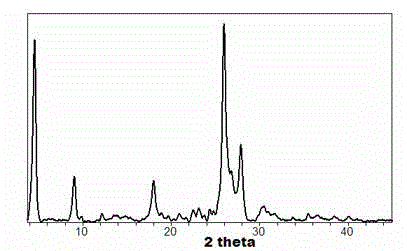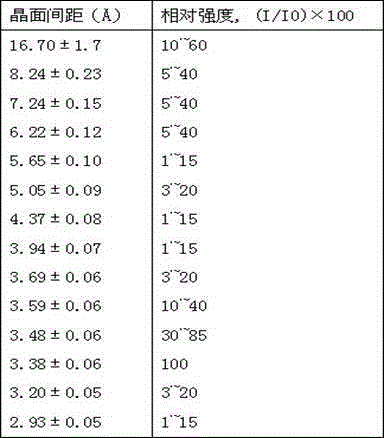SCM-3 molecular sieve and preparation method thereof
A SCM-3, molecular sieve technology, applied in molecular sieves and alkali exchange compounds, chemical instruments and methods, inorganic chemistry, etc., can solve the problems of undiscovered materials, the Kenyaite structure is not stable enough, etc., and achieve good application prospects and high thermal stability. Effect
- Summary
- Abstract
- Description
- Claims
- Application Information
AI Technical Summary
Problems solved by technology
Method used
Image
Examples
Embodiment 1
[0031] With 0.863 grams of boric acid, 0.41 grams of NaCl, 1.1175 grams of 30% sodium hydroxide aqueous solution, 10 grams of 50% PEG 300 (polyethylene glycol with an average molecular weight of about 300) solution, 11 grams of water and 8.1 milliliters of 40% silica sol solution is mixed evenly, and the molar proportion of gained mixture is:
[0032] 10SiO 2 : 0.4B 2 o 3 : 1.0NaCl: 0.6Na 2 O: 2.5PEG 300: 175H 2 o
[0033] Move the above mixture into the reactor at 180 o C was crystallized for 40 hours, washed and dried after the reaction, and identified as Kenyaite material by XRD, see figure 1 .
[0034] Mix 1 gram of the above-mentioned Kenyaite material with 20 ml of 0.1M hydrochloric acid, stir at 20°C for 24 hours, wash, separate solid from liquid, and dry to obtain a solid product treated with hydrochloric acid. Calcined for 3 hours to obtain SCM-3 molecular sieve, the X-ray diffraction lines of which are shown in Table 1.
[0035]
Embodiment 2
[0037] With 0.863 grams of boric acid, 0.41 grams of NaCl, 1.1175 grams of 30% sodium hydroxide aqueous solution, 10 grams of 50% PEG 300 (polyethylene glycol with an average molecular weight of about 300) solution, 11 grams of water and 8.1 milliliters of 40% silica sol solution is mixed evenly, and the molar proportion of gained mixture is:
[0038] 10SiO 2 : 0.4B 2 o 3 : 1.0NaCl: 0.6Na 2 O: 2.5PEG 300: 175H 2 o
[0039] Move the above mixture into the reactor at 180 o C was crystallized for 40 hours, washed and dried after the reaction, and was identified as Kenyaite material by XRD.
[0040] Mix 1 gram of the above-mentioned Kenyaite material with 20 ml of 0.5M acetic acid, stir in a closed system at 80°C for 24 hours, wash, separate solid-liquid and dry to obtain a solid product, and roast the solid product at 700°C for 3 hours , to obtain SCM-3 molecular sieve, whose X-ray diffraction lines are shown in Table 2.
[0041]
Embodiment 3
[0043] With 0.863 grams of boric acid, 0.41 grams of NaCl, 1.1175 grams of 30% sodium hydroxide aqueous solution, 10 grams of 50% PEG 300 (polyethylene glycol with an average molecular weight of about 300) solution, 11 grams of water and 8.1 milliliters of 40% silica sol solution is mixed evenly, and the molar proportion of gained mixture is:
[0044] 10SiO 2 : 0.4B 2 o 3 : 1.0NaCl: 0.6Na 2 O: 2.5PEG 300: 175H 2 o
[0045] Move the above mixture into the reactor at 180 o C was crystallized for 40 hours, washed and dried after the reaction, and was identified as Kenyaite material by XRD.
[0046] Mix 1 gram of the above-mentioned Kenyaite material with 20 ml of 0.1M hydrochloric acid, stir at 20°C for 24 hours, wash, separate solid from liquid, and dry to obtain a hydrochloric acid-treated solid product. The hydrochloric acid-treated solid product is obtained in Calcined at 800° C. for 3 hours to obtain SCM-3 molecular sieve, whose X-ray diffraction lines are shown in Ta...
PUM
 Login to View More
Login to View More Abstract
Description
Claims
Application Information
 Login to View More
Login to View More - R&D
- Intellectual Property
- Life Sciences
- Materials
- Tech Scout
- Unparalleled Data Quality
- Higher Quality Content
- 60% Fewer Hallucinations
Browse by: Latest US Patents, China's latest patents, Technical Efficacy Thesaurus, Application Domain, Technology Topic, Popular Technical Reports.
© 2025 PatSnap. All rights reserved.Legal|Privacy policy|Modern Slavery Act Transparency Statement|Sitemap|About US| Contact US: help@patsnap.com



